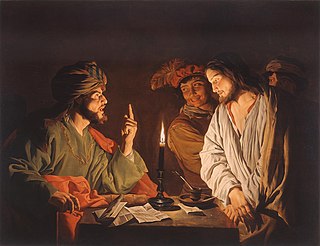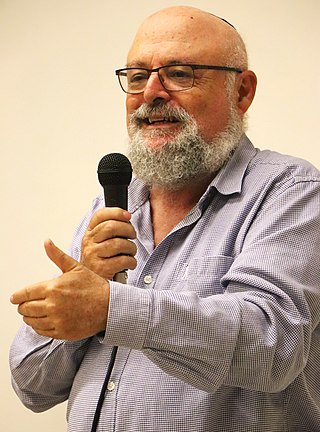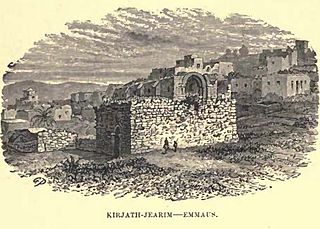Related Research Articles

Flavius Josephus or Yosef ben Mattityahu was a Roman–Jewish historian and military leader. Best known for writing The Jewish War, he was born in Jerusalem—then part of the Roman province of Judea—to a father of priestly descent and a mother who claimed royal ancestry.

Historically, many rulers have assumed titles such as the son of God, the son of a god or the son of heaven.

Herod I or Herod the Great was a Roman Jewish client king of the Herodian Kingdom of Judea. He is known for his colossal building projects throughout Judea. Among these works are the rebuilding of the Second Temple in Jerusalem and the expansion of its base—the Western Wall being part of it. Vital details of his life are recorded in the works of the 1st century CE Roman–Jewish historian Josephus.

Herod Agrippa, also known as Herod II or Agrippa I, was the last Jewish king of Judea. He was a grandson of Herod the Great and the father of Herod Agrippa II, the last known king from the Herodian dynasty. He was acquaintance or friend of Roman emperors and even played crucial roles in internal Roman politics.

Herod Agrippa II, officially named Marcus Julius Agrippa and sometimes shortened to Agrippa, was the last ruler from the Herodian dynasty, reigning over territories outside of Judea as a Roman client. Agrippa II fled Jerusalem in 66, fearing the Jewish uprising and supported the Roman side in the First Jewish–Roman War.
Annas was appointed by the Roman legate Quirinius as the first High Priest of the newly formed Roman province of Judaea in AD 6 – just after the Romans had deposed Archelaus, Ethnarch of Judaea, thereby putting Judaea directly under Roman rule.

Zechariah is a Jewish figure in the New Testament and the Quran, and venerated in Christianity and Islam. In the Bible, he is the father of John the Baptist, a priest of the sons of Aaron in the Gospel of Luke, and the husband of Elizabeth who is a relative of the Virgin Mary.

Josef Ben Caiaphas, known simply as Caiaphas in the New Testament, was the High Priest of Israel during the years of Jesus' ministry, according to Josephus. The Gospels of Matthew, Luke and John indicate he was an organizer of the plot to kill Jesus. He famously presided over the Sanhedrin trial of Jesus. The primary sources for Caiaphas' life are the New Testament, and the writings of Josephus. The latter records he was made high priest by the Roman procurator Valerius Gratus after Simon ben Camithus had been deposed.

Herod Archelaus was the ethnarch of Samaria, Judea, and Idumea, including the cities Caesarea and Jaffa, for nine years. He was the son of Herod the Great and Malthace the Samaritan, brother of Herod Antipas, and half-brother of Herod II. Archelaus came to power after the death of his father Herod the Great in 4 BC, and ruled over one-half of the territorial dominion of his father. Archelaus was removed by the Roman emperor Augustus when Judaea province was formed under direct Roman rule, at the time of the Census of Quirinius.

Judaea was a Roman province from 6 to 132 AD, which incorporated the Levantine regions of Idumea, Philistia, Judea, Samaria, and Galilee, extending over parts of the former regions of the Hasmonean and Herodian kingdoms of Judea. The name Judaea was derived from the Iron Age Kingdom of Judah, that was centered predominantly in Judea.

John 4 is the fourth chapter of the Gospel of John in the New Testament of the Christian Bible. The major part of this chapter recalls Jesus' conversation with the Samaritan woman at the well in Sychar. In verses 43-54, he returns to Galilee, where he heals a royal official's son.

Perea or Peraea was the term used mainly during the early Roman period for part of ancient Transjordan. It lay broadly east of Judea and Samaria, which were situated on the western side of the Jordan River, and southwest of the Decapolis.

Israel Knohl is an Israeli Bible scholar and historian. He is the Yehezkel Kaufmann Professor of Biblical studies at the Hebrew University of Jerusalem and a Senior Fellow at Shalom Hartman Institute in Jerusalem. His books deal with the integration of scientific and archaeological discoveries with the biblical account, early Israelite beliefs, a survey of Israelite cult, and how and where the Israelites originated.
In Jewish eschatology Mashiach ben Yoseph or Messiah ben Joseph, also known as Mashiach bar/ben Ephraim, is a Jewish messiah from the tribe of Ephraim and a descendant of Joseph. The figure's origins are much debated. Some regard it as a rabbinic invention, but others defend the view that its origins are in the Torah.

According to Josephus, Athogod or Athrongeus was a leader of the Jews during the insurrection under Herod Archelaus. Athronges led the rebellion against Archelaus and the Romans.

Gabriel's Revelation, also called Hazon Gabriel or the Jeselsohn Stone, is a stone tablet with 87 lines of Hebrew text written in ink, containing a collection of short prophecies written in the first person. It is dated to the late 1st century BCE or early 1st century CE and is important for understanding Jewish messianic expectations in the Second Temple period.
Costobarus was an associate of Herod the Great and second husband of Herod's sister Salome I. He was also known as Costobar.
Menahem ben Judah lived around the time of the First Jewish–Roman War and is mentioned by Josephus. He was the leader of a faction called the Sicarii who carried out assassinations of Romans and collaborators in the Holy Land.

Publius Sulpicius Quirinius, also translated as Cyrenius, was a Roman aristocrat. After the banishment of the ethnarch Herod Archelaus from the tetrarchy of Judea in AD 6, Quirinius was appointed legate governor of Syria, to which the province of Judaea had been added for the purpose of a census.

This article lists historical events that occurred between 1–100 in modern-day Lebanon or regarding its people.
References
- 1 2 3 4 "Simon of Perea". Livius.org. 2001. Retrieved 11 July 2020.
- ↑ Flavius Josephus, Jewish War 2.57-59 and Jewish Antiquities 17.273-277
- ↑ Knohl, Israel (April 19, 2007). "In three days, you shall live". Haaretz. Retrieved 2008-07-10.
- ↑ "THE FIRST JESUS FACTS" channel.nationalgeographic.com Archived 2010-08-19 at the Wayback Machine
- 1 2 Israel Knohl, "The Apocalyptic and Messianic Dimensions of the Gabriel Revelation in Their Historical Context", in Matthias Henze (ed.), Hazon Gabriel: New Readings of the Gabriel Revelation (Early Judaism and Its Literature 29), Atlanta: Society of Biblical Literature, 2011.